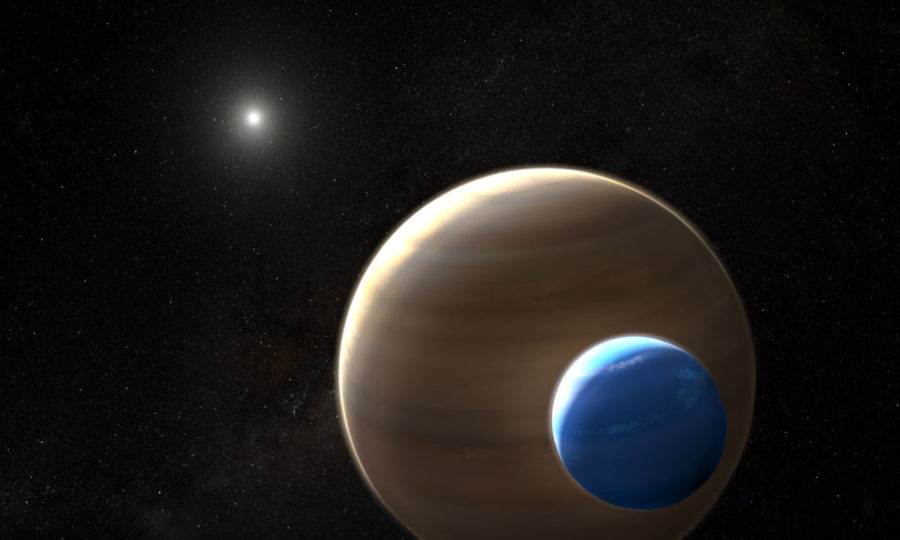Evidence of Distant Moons, Voyager 2 To Reach Interstellar Space, Falcon 9 Launch Plumes
October 18, 2018
Moons in Kepler-1625
Getting a clear picture of a distant world, a world from another solar system, dozens of light years away from Earth, is a dream that many wish would come true. Of course, being able to get that precise of an image isn’t possible with today’s technology, nor with the technology of the near future.
However, we do have the technology to detect and find planets by observing sudden dimness in a star due to a planet’s orbiting in front of it, thus causing something similar to a mini-eclipse. As of Oct. 1, there have been 3,851 of these planets observed, which are known as exoplanets.
But for the first time on Oct. 3, possible evidence of a moon was discovered, in the solar system Kepler-1625, about 8,000 light years away. The moon is believed to orbit a gas giant several times the size of Jupiter, and the moon itself would be the size of Neptune.
A moon the size of Neptune is incredibly hard to believe, considering the largest moon in our solar system, Jupiter’s moon Ganymede, is just two-=fifths the size of Earth. That makes the distant moon nine times the size of our biggest moon.
“This finding shows how NASA’s missions uncover incredible mysteries in our cosmos,” said Thomas Zurbuchen, associate administrator of NASA’s Science Mission Directorate. “If confirmed, this finding could completely shake our understanding of how moons are formed and what they can be made of.”
The moon was discovered soon after the distant gas giant passed the sun. Three hours after the planet passed and the star’s dimness reached its normal level, it dipped again, but only slightly.
Another piece of evidence was the delay of the planet’s expected time to go in front of the sun. It came an hour later than expected, suggesting that its moon could have pulled on it, like all moons do, affecting its orbit around the sun.
This is not definite evidence, however, as a small dip in light from a star 8,000 light years ago is not solid proof that there is a moon. Another planet in the solar system could have had a small gravitational pull on the gas giant, resulting in its delayed orbit, and the dip in dimness could have been a much smaller planet, not a moon.
But who doesn’t want to believe it’s a moon?

Voyager 2 To Join It’s Brother Space Probe
Voyager 1 became the first manmade object to leave the solar system and enter Interstellar space in 2012, after doing a daring tour of the outer planets just 30 years prior.
What counts as interstellar space is anything outside of the “heliosphere,” an incredibly large ovular “bubble” created by the sun that is made up of solar winds constantly discharged by the sun until it is eventually dissolved by interstellar space. The bubble extends well beyond even Pluto, more than three times its distance from the sun.
Now, six years after Voyager 1 completed the daunting task, Voyager 2 is close to completing the same legendary feat as well.
Three months before Voyager 1 exited the heliosphere bubble, it began to experience a drastic increase in cosmic rays. Once the craft “popped out” of the heliopause (the boundary), the rays disappeared.
But now that Voyager 2 is beginning to go through the same cosmic rays, the Voyager team conjectures that this does not exactly mean that it is also close to breaking free. Voyager 2 is in a different part of the “heliosheath,” the shortest distance from the Sun to interstellar space. Scientists believe that part of the heliosheath could be much farther from the heliopause than Voyager 1 was.
“We’re seeing a change in the environment around Voyager 2,” said Voyager Project Scientist Ed Stone, referring to the slow growth and retracting movements that the heliopause constantly experiences. “We’re going to learn a lot in the coming months, but we still don’t know when we’ll reach the heliopause.”
Although the exact date that Voyager 2 will breach the heliopause isn’t exactly marked, it will certainly be soon.

Falcon 9 Exhaust Plumes
Oct. 7 was a successful day for SpaceX, which launched the SAOCOM 1A satellite, an Argentinian Earth-observing satellite, and then for the first time landed the Falcon 9 booster at the Vandenberg Air Force Base in California, marking SpaceX’s first West Coast landing.
When Falcon 9 launched at around 7:30 p.m. PDT, the sun was just barely setting beyond the horizon. When Falcon 9 was high enough, the sun was finally in view of the rocket, and the sun’s light reflected off of the rocket’s exhaust, resulting in a beautiful light show.


